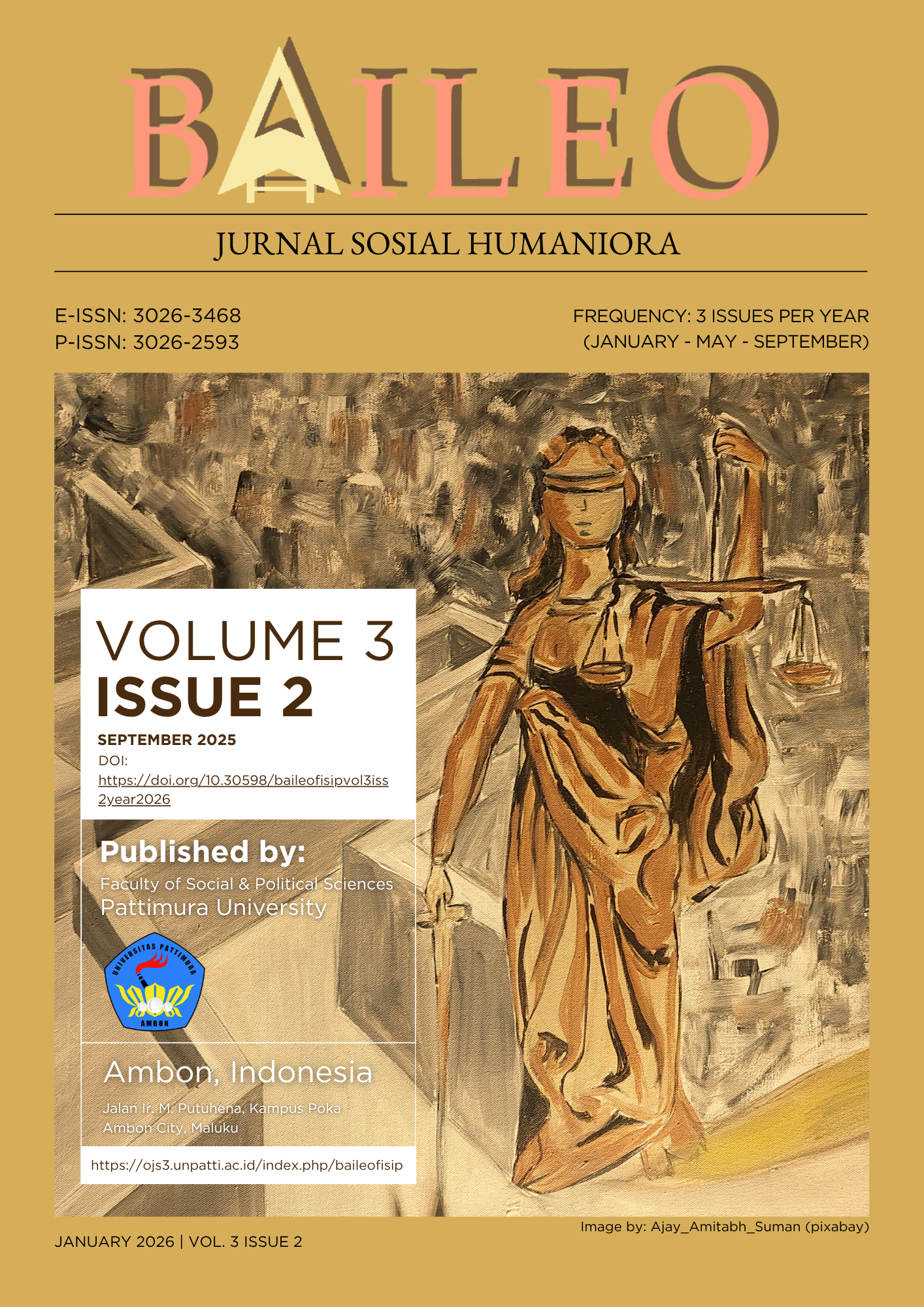Governing Health in High-Risk Bureaucracies: Institutional Misalignment and Reactive Policy Implementation in the Indonesian National Police
Abstract
This study examines the institutional governance of occupational health within high-risk law enforcement institutions through a case study of the Indonesian National Police (INP), focusing on the misalignment between formal policy design and reactive implementation practices. Despite regulatory mandates such as the Chief of Police Regulation No. 7/2013 requiring periodic health screenings, participation remains low (24–26%), while high-risk classifications have tripled within a year. Using a qualitative case study approach, institutional screening data and medical records from the Jakarta Metropolitan Police (Polda Metro Jaya) were analyzed through documentary and thematic content analysis guided by Matland’s ambiguity–conflict model and policy implementation theory. The findings reveal that bureaucratic quota systems, weak digital infrastructure, and the absence of leadership accountability mechanisms undermine preventive health outcomes, leading to rising chronic diseases, preventable deaths, and declining institutional resilience. The study identifies systemic governance failures driven by compliance-oriented routines and proposes four reforms: risk-adaptive screening protocols, centralized digital health integration, leadership accountability metrics, and cross-sectoral preventive care partnerships. The novelty of this research lies in exposing institutional misalignment in police health governance, an underexplored area in Indonesian bureaucratic sociology, while extending the New Public Service paradigm to occupational health governance. Conceptually, it contributes to institutional sociology by linking policy rationality with frontline implementation behavior in high-risk public sectors.
Downloads
References
Alika, Y., Valentina, T. R., & Hendrik, D. (2024). Bureaucratic Politicization in the Process of Changing Bureaucratic Positions After the Vacancy of the Deputy Regent of Dharmasraya Regency in 2022. Jurnal Ilmiah Ekotrans & Erudisi, 4(1), 1–15. https://doi.org/10.69989/0dbm5230
Ananthapavan, J., Moodie, M., Milat, A., Veerman, L., Whittaker, E., & Carter, R. (2021). A cost–benefit analysis framework for preventive health interventions to aid decision-making in Australian governments. Health Research Policy and Systems, 19(1), 147. https://doi.org/10.1186/s12961-021-00796-w
Asadi-Lari, M., Ahmadi Teymourlouy, A., Maleki, M., & Afshari, M. (2021). Opportunities and challenges of global health diplomacy for prevention and control of noncommunicable diseases: a systematic review. BMC Health Services Research, 21(1), 1193. https://doi.org/10.1186/s12913-021-07240-3
Aspers, P., & Corte, U. (2019). What is Qualitative in Qualitative Research. Qualitative Sociology, 42(2), 139–160. https://doi.org/10.1007/s11133-019-9413-7
Asriyanti, N., Nugroho, A., & Yulianti, R. (2020). Pelayanan Publik Melalui Sistem E-Filling di Kantor Pelayanan Pajak Pratama Cilegon. JDKP : Jurnal Desentralisasi Dan Kebijakan Publik, 1(1), 35–42. https://doi.org/10.30656/jdkp.v1i1.2246
Becker, L., Coussement, K., Büttgen, M., & Weber, E. (2022). Leadership in innovation communities: The impact of transformational leadership language on member participation. Journal of Product Innovation Management, 39(3), 371–393. https://doi.org/10.1111/jpim.12588
Bentancur, N., Bidegain, G., & Martinez, R. (2023). The study of public policies in political science: Contributions, debates, and challenges. Gestión y Política Pública, 32(2), 187–217. https://doi.org/10.60583/gypp.v32i2.8127
Bryda, G., & Costa, A. P. (2023). Qualitative Research in Digital Era: Innovations, Methodologies and Collaborations. Social Sciences, 12(10), 570. https://doi.org/10.3390/socsci12100570
Carter, P. M., Losman, E., Roche, J. S., Malani, P. N., Kullgren, J. T., Solway, E., Kirch, M., Singer, D., Walton, M. A., Zeoli, A. M., & Cunningham, R. M. (2022). Firearm ownership, attitudes, and safe storage practices among a nationally representative sample of older U.S. adults age 50 to 80. Preventive Medicine, 156(3), 106955. https://doi.org/10.1016/j.ypmed.2022.106955
Cartwright, A., & Roach, J. (2021). The Wellbeing of UK Police: A Study of Recorded Absences from Work of UK Police Employees Due to Psychological Illness and Stress Using Freedom of Information Act Data. Policing: A Journal of Policy and Practice, 15(2), 1326–1338. https://doi.org/10.1093/police/paaa033
Cloeren, M., Dement, J., Ghorbanpoor, K., Almashat, S., Grier, W., Quinn, P., Cranford, K., Chen, A., Haas, S., & Ringen, K. (2025). Colorectal Cancer (CRC) Screening in Occupational Health Surveillance Exams Is Associated With Decreased CRC Mortality. American Journal of Industrial Medicine, 68(2), 202–209. https://doi.org/10.1002/ajim.23688
Denhardt, J. V, & Denhardt, R. B. (2018). The New Public Service (3rd ed.). Routledge. https://doi.org/10.4324/9781315699356
Doyle, L., McCabe, C., Keogh, B., Brady, A., & McCann, M. (2020). An overview of the qualitative descriptive design within nursing research. Journal of Research in Nursing, 25(5), 443–455. https://doi.org/10.1177/1744987119880234
Ebinger, F., Veit, S., & Strobel, B. (2022). Role Models in the Senior Civil Service: How Tasks Frame the Identification of Senior Bureaucrats with Active and Reactive Roles. International Journal of Public Administration, 45(14), 991–1002. https://doi.org/10.1080/01900692.2021.1945623
Ghotbi, N. (2022). The COVID-19 Pandemic Response and Its Impact on Post-Corona Health Emergency and Disaster Risk Management in Iran. Sustainability, 14(22), 14858. https://doi.org/10.3390/su142214858
Goetzel, R. Z., & Ozminkowski, R. J. (2018). The Health and Cost Benefits of Work Site Health-Promotion Programs. Annual Review of Public Health, 29(1), 303–323. https://doi.org/10.1146/annurev.publhealth.29.020907.090930
Gorgenyi-Hegyes, E., Nathan, R. J., & Fekete-Farkas, M. (2021). Workplace Health Promotion, Employee Wellbeing and Loyalty during Covid-19 Pandemic, Large Scale Empirical Evidence from Hungary. Economies, 9(2), 55. https://doi.org/10.3390/economies9020055
Hassan, M. S., Al Halbusi, H., Ahmad, A. B., Abdelfattah, F., Thamir, Z., & Raja Ariffin, R. N. (2023). Discretion and its effects: analyzing the role of street-level bureaucrats’ enforcement styles. International Review of Public Administration, 28(4), 480–502. https://doi.org/10.1080/12294659.2023.2286671
Hieng, B. B., & Prabawati, N. P. A. (2024). Digital Transformation in Villages: A Policy Implementation Approach in Kajowair Village, Nusa Tenggara Timur. Baileo: Jurnal Sosial Humaniora, 2(2), 189–198. https://doi.org/10.30598/baileofisipvol2iss2pp189-198
Hill, M., & Hupe, P. (2018). Implementing public policy: An introduction to the study of operational governance (3rd ed.). SAGE Publications. https://doi.org/10.1080/09537287.2012.666915
Jansen, E., Javornik, J., Brummel, A., & Yerkes, M. A. (2021). Central‐local tensions in the decentralization of social policies: Street‐level bureaucrats and social practices in the Netherlands. Social Policy & Administration, 55(7), 1262–1275. https://doi.org/10.1111/spol.12722
Kanol, D. (2022). Narrative strategies for emerging disruptive technologies: A case study of Blockchain for Europe. Politics & Policy, 50(5), 952–966. https://doi.org/10.1111/polp.12492
Kervezee, L., Gonzales-Aste, F., Boudreau, P., & Boivin, D. B. (2021). The relationship between chronotype and sleep behavior during rotating shift work: a field study. Sleep, 44(4), 225. https://doi.org/10.1093/sleep/zsaa225
Khoa, B. T., Hung, B. P., & Brahmi, M. H. (2023). Qualitative research in social sciences: data collection, data analysis and report writing. International Journal of Public Sector Performance Management, 12(2), 187–209. https://doi.org/10.1504/IJPSPM.2023.132247
Lagoe, C. A., Newcomer, D., & Fico, A. (2023). Formative research for a social marketing safety campaign at a biomedical research facility. Journal of Social Marketing, 13(4), 510–527. https://doi.org/10.1108/JSOCM-11-2022-0230
Lambin, R. A., & Nyyssölä, M. (2024). Tanzanian social policy in the new millennium – a cross-sectoral analysis from a gender perspective. International Journal of Sociology and Social Policy, 44(13/14), 49–67. https://doi.org/10.1108/IJSSP-01-2023-0007
Lipsky, M. (2018). Street-Level Bureaucracy: Dilemmas of the Individual in Public Services. Michigan Law Review, 79(4), 811. https://doi.org/10.2307/1288305
Lissåker, C. T., Gustavsson, P., Albin, M., Ljungman, P., Bodin, T., Sjöström, M., & Selander, J. (2021). Occupational exposure to noise in relation to pregnancy-related hypertensive disorders and diabetes. Scandinavian Journal of Work, Environment & Health, 47(1), 33–41. https://doi.org/10.5271/sjweh.3913
Martin, C. J., Pastore, M., & Christiansen, P. M. (2023). The culture of education regimes: Efficiency, equality and governance in education and social policy. Social Policy & Administration, 57(2), 204–218. https://doi.org/10.1111/spol.12895
Matland, R. E. (2018). Synthesizing the Implementation Literature: The Ambiguity-Conflict Model of Policy Implementation. Journal of Public Administration Research and Theory, 5(2), 145–174. http://www.jstor.org/stable/1181674?origin=JSTOR-pdf
McLaughlan, R., & Lodge, J. M. (2019). Facilitating epistemic fluency through design thinking: a strategy for the broader application of studio pedagogy within higher education. Teaching in Higher Education, 24(1), 81–97. https://doi.org/10.1080/13562517.2018.1461621
Mess, F., Blaschke, S., Gebhard, D., & Friedrich, J. (2024). Precision prevention in occupational health: a conceptual analysis and development of a unified understanding and an integrative framework. Frontiers in Public Health, 12(6), e435–e439. https://doi.org/10.3389/fpubh.2024.1444521
Michele, B., Luisa, C. M., Martina, L. C., & Simone, B. (2023). Migrants in the economy of European rural and mountain areas. A cross-national investigation of their economic integration. Journal of Rural Studies, 99(4), 62–70. https://doi.org/10.1016/j.jrurstud.2023.02.010
Ndlela, N. H., & Naidoo, R. N. (2023). Job and exposure intensity among hospital cleaning staff adversely affects respiratory health. American Journal of Industrial Medicine, 66(3), 252–264. https://doi.org/10.1002/ajim.23456
Or, Z., Gandré, C., Durand Zaleski, I., & Steffen, M. (2022). France’s response to the Covid-19 pandemic: between a rock and a hard place. Health Economics, Policy and Law, 17(1), 14–26. https://doi.org/10.1017/S1744133121000165
Organization, I. L. (2024). Global strategy on occupational safety and health 2024-2030. https://www.ilo.org/wcmsp5/groups/public/---ed_protect/---protrav/---safework/documents/publication/wcms_897539.pdf
Ramli, V., Anwary, I., Suprapto, S., & Erlina, E. (2025). Reforming the Bureaucratic Frontiers: An Analysis of Legal Implications, Concepts and Challenges for Non-Civil Servant Employees in Indonesia. Strata Law Review, 3(2), 102–114. https://doi.org/10.59631/slr.v3i2.435
Rivera, J. D., & Knox, C. C. (2023). Bureaucratic discretion, social equity, and the administrative legitimacy dilemma: Complications of New Public Service. Public Administration Review, 83(1), 65–77. https://doi.org/10.1111/puar.13550
Rose, G., Raghuram, P., Watson, S., & Wigley, E. (2021). Platform urbanism, smartphone applications and valuing data in a smart city. Transactions of the Institute of British Geographers, 46(1), 59–72. https://doi.org/10.1111/tran.12400
Sardana, N., Shekoohi, S., Cornett, E. M., & Kaye, A. D. (2023). Qualitative and quantitative research methods. In Substance Use and Addiction Research (pp. 65–69). Elsevier. https://doi.org/10.1016/B978-0-323-98814-8.00008-1
Shishavan, H. H., Garza, J., Henning, R., Cherniack, M., Hirabayashi, L., Scott, E., & Kim, I. (2023). Continuous physiological signal measurement over 24-hour periods to assess the impact of work-related stress and workplace violence. Applied Ergonomics, 108, 103937. https://doi.org/10.1016/j.apergo.2022.103937
Smith-MacDonald, L., Lentz, L., Malloy, D., Brémault-Phillips, S., & Carleton, R. N. (2021). Meat in a Seat: A Grounded Theory Study Exploring Moral Injury in Canadian Public Safety Communicators, Firefighters, and Paramedics. International Journal of Environmental Research and Public Health, 18(22), 12145. https://doi.org/10.3390/ijerph182212145
Stanley, M. (2023). Qualitative Descriptive. In Qualitative Research Methodologies for Occupational Science and Occupational Therapy (pp. 52–67). Routledge. https://doi.org/10.4324/9781003456216-4
Subramony, M., Golubovskaya, M., Keating, B., Solnet, D., Field, J., & Witheriff, M. (2022). The influence of pandemic-related workplace safety practices on frontline service employee wellbeing outcomes. Journal of Business Research, 149(2), 363–374. https://doi.org/10.1016/j.jbusres.2022.05.040
Sulaiman, S., Trimawarni, A., Wahyuni, E., & Listiana, Y. D. (2024). Toward A Smart City Pontianak: A Study of Digital Governance Effectiveness As A Moderator of The Relationship Between Work Culture, HR Management, and Public Satisfaction. Baileo: Jurnal Sosial Humaniora, 2(2), 120–129. https://doi.org/10.30598/baileofisipvol2iss2pp120-129
Taquette, S. R., & Souza, L. M. B. da M. (2022). Ethical Dilemmas in Qualitative Research: A Critical Literature Review. International Journal of Qualitative Methods, 21(12), 8731. https://doi.org/10.1177/16094069221078731
Teddy, G., Lembani, M., Hwabamungu, B., & Molosiwa, D. (2019). Policy and Implementation Gap: A Multi-Country Perspective. International Journal of Advanced Research, 7(12), 678–704. https://doi.org/10.21474/IJAR01/10197
Tuzovic, S., & Kabadayi, S. (2021). The influence of social distancing on employee well-being: a conceptual framework and research agenda. Journal of Service Management, 32(2), 145–160. https://doi.org/10.1108/JOSM-05-2020-0140
Wang, A., Li, Y., Zhou, L., Liu, K., Li, S., Zong, C., Song, B., Gao, Y., Li, Y., Tian, C., Xing, Y., Xu, Y., & Wang, L. (2022). Non-HDL-C/HDL-C ratio is associated with carotid plaque stability in general population: A cross-sectional study. Frontiers in Neurology, 13(1), 134. https://doi.org/10.3389/fneur.2022.875134
Yakubu, A., & Chaudhuri, S. (2022). Potential opportunities and challenging realities: Organizations’ experiences while accessing resources and advocating on behalf of survivors of domestic violence in Ghana. Women’s Studies International Forum, 94(3), 102620. https://doi.org/10.1016/j.wsif.2022.102620
Yun, B., Oh, J., Choi, J., Rozek, L. S., Park, H., Sim, J., Kim, Y., Lee, J., & Yoon, J.-H. (2023). Socioeconomic Disparities in the Association Between All-Cause Mortality and Health Check-Up Participation Among Healthy Middle-Aged Workers: A Nationwide Study. Journal of Korean Medical Science, 38(50), e384. https://doi.org/10.3346/jkms.2023.38.e384
Zhang, S., & Zhang, Y. (2021). The Relationship Between Internet Use and Mental Health Among Older Adults in China: The Mediating Role of Physical Exercise. Risk Management and Healthcare Policy, Volume 14(3), 4697–4708. https://doi.org/10.2147/RMHP.S338183
Copyright (c) 2026 Niken Manohara, Triyuni Soemartono, T. Herry Rachmatsyah, Gatot Hery Djatmiko

This work is licensed under a Creative Commons Attribution 4.0 International License.




